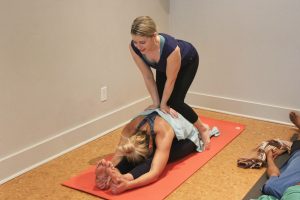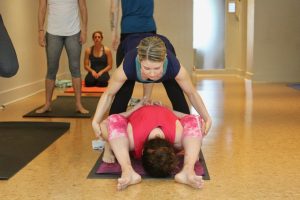This week I had the pleasure of sitting down with the wonderful Elyse to talk about all things related to teaching and assisting Ashtanga.
If you’ve ever practiced at AYCT, chances are you’ve seen the bright and smiling face of Elyse Mason. She is David’s right hand assistant in the morning, and the main teacher when he travels. She’s the small one with the blonde hair and friendly smile. But don’t let her petite frame fool you – she’ll pretzel you into Marichyasana D or Supta Kurmasana with the strength and technique that only skilled teachers possess. Elyse has been assisting and teaching Ashtanga for over 5 years, and I don’t want to brag or anything but… she’s pretty great! So when I wanted to get an idea about what Teaching and Assisting Mysore is like, I knew exactly who I wanted to ask!
For anyone who is interested in assisting and teaching Ashtanga Yoga, this article is an incredible resource!

AYCT: How long have you been Assisting for, and when did you start practicing at AYCT?
Elyse: I’ve been assisting for about 4 years now, but I started practicing in the summer of 2013. I took David’s Primary Series Intensive and then I started coming to AYCT right after that.
AYCT: What made you want to start assisting?
Elyse: I did a teacher training in Thailand, and I practiced Mysore style Ashtanga for the first time. I would get really good adjustments from the assistants and I was so grateful for them. I remember thinking, “I want to be that person for someone else.” As soon as I experienced assists in a Mysore setting I was like “I wanna do that.”
AYCT: What was your experience like with assisting school?
Elyse: I was really nervous. I almost didn’t take it, because I was intimidated. David actually came up to me one day in the room one day and asked if I was taking Assisting School, and I said ‘No.’ When he asked me why, I told him it was because I was intimidated. He just gave me this look, and said “But I thought that you wanted to teach?” He was right. I went home that day and signed up for assisting school. He didn’t let my fear and intimidation stand in the way, and I’m so grateful for that.
Assisting School was definitely challenging. But it was mostly fun. The hardest part was the actual assisting, and dealing with my own fears and my own nerves.
I liked it when assistants built a relationship with me before they took on too much assisting me. So I wanted to keep that in mind when I was assisting. I was going into a room assisting people I’d never helped before, and my fear was basically that I’d go to assist someone and that they’d be annoyed, or get frustrated if my assist wasn’t good. I also didn’t want to pull students out of their practice. There’s nothing worse than when you’re deeply connected with your breath, and someone comes and gives you an unnecessary adjustment.
My fear was getting a reaction of resistance from students. But I found out that that’s going to happen, and that’s ok. It’s just a part of the process. You can’t build a relationship with someone without approaching them in the first place.
Now I tell new assistants to expect this, even though it was my worst fear.

AYCT: What is the biggest learning curve when you first start assisting?
Elyse: My biggest learning curve was building confidence. Because that was the whole thing – I was afraid to approach people because I was afraid I wasn’t good enough. People react to confidence, and some people have it right off the bat. But I felt like I had to earn my confidence. I didn’t feel like I had the right to walk in with so much confidence, when this was something I had never done before.
Another one of the biggest challenges is the physicality of it. There is a learning curve to figuring out the technique. At first you’ll learn the assists and muscle your way through it. But over time, with practice you learn how to make it a little easier on yourself.
AYCT: What do you think is the hardest thing about assisting?
Elyse: I think one of the hardest things about being an assistant is not making it about you, but making it about students and the space. Like if you start to make it about you, if you give an assist or do something hoping that you’ll get great feedback, that’s about you, that’s not about the students or the space. Your role is to assist and try to keep the students in their practice. When you talk too much, you take them out of their practice. When you give unnecessary adjustments, you take people out of their practice.
Sometimes the role of the assistant – and what could be hard for someone – is to NOT assist someone. To let them sit in silence, and be in their body. One thing that might be helpful before you assist someone is to ask yourself, ‘is this about them or is it about me?’

AYCT: Now you are also teaching Mysore, tell me about the differences between teaching and assisting?
Elyse: To start, teachers do most of the talking in the room. So as an assistant you don’t talk a lot. As an assistant my first concern is the safety of the student, and helping students meet the conditions of the asana. It’s not about deepening their posture.
The teacher is responsible for decision making in the room. Whether that be giving someone a new pose, modifying a students practice, or choosing to help someone deepen an asana. The teacher also delegates to the assistant.
The way I see assisting, is that I’m there to support the students and the teacher. When you’re assisting you have two roles, Where as when I’m teaching I feel like my responsibility is for the students.
AYCT: What do you feel is the role of ParamPara in teaching and assisting?
Elyse: A part of the practice is surrender to the lineage, and to the asana practice itself. It’s important to have consistency in assisting, and in the practice in general. So that’s why I just follow what David tells me. I think that’s hard for some people. That’s where the ego comes in. It’s letting go of that voice saying, “Oh I know better,” or wanting to make a name for yourself.
Ekhart Tolle says something along the lines of, “If you want to burn up the ego, you have to be ok with being nobody.” If you standing out as a teacher is what is guiding you, you are probably going to struggle a lot with assisting. I feel like being an assistant is a practice in itself. It’s a practice in letting go of your ego.

AYCT: How do you deal with a negative reaction from a student during an assist?
Elyse: I’ve learned that peoples reactions are mostly about them, they aren’t about you – even the positive reactions. If someone thinks you’re amazing, you have to try not to take any of it personally. The harder thing, is to not take the positive stuff personally. Because that’s letting go of the ego.
I think that when you start you just wanna be a good assistant. You wanna hear good feedback and validation from people. But it takes time to realize that it’s not your job to do the pose for someone, rather you’re there to support them.
And supporting them sometimes means you’re not going to get the reaction you want.
I definitely have a lot of respect for all the students that come in because its such a difficult practice. I have a respect for the practice itself. That’s part of what makes me nervous. Even though my confidence has grown over the years, I’ll always be a littler nervous teaching and assisting because to me, this job is a privilege.
You can find Elyse in the Mysore room every morning from 5:30am to 9:30am. Want to learn how to assist like she does? Check out our programs! Our Primary Series Intensive runs from July 7-13, and Assisting School runs from July 14-August 3 and are hosted by our very own David Robson and Jelena Vesic.
Maybe you can come?

Elyse! I observed her transform over the years from a timid assistant to one of the best I’ve ever encountered. I miss some of her amazing assists now that I’m gone. Thanks for sharing your story.
So grateful to have you in my life Elise 🙂 Thank you for everything you do…
Thank’s for sharing such and awesome post. Keep always sharing such a post.